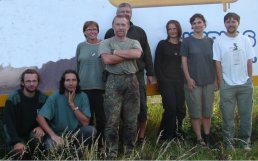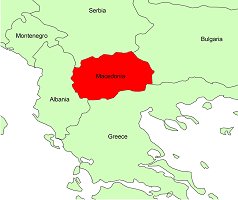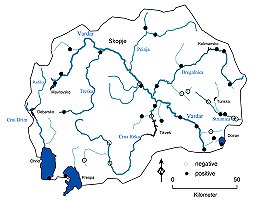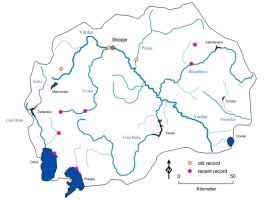 |
Last Update:
Thursday November 22, 2018
|
| [Home] |
INTRODUCTION Until 1991 the territory of the Republic of Macedonia was part of Yugoslavia and otter was assumed as widespread there (Foster-Turley et al., 1990). However, the atlas of Mammals in Europe (Mitchell-Jones et al., 1999) shows a gap in distribution respectively knowledge just in the area of the Republic of Macedonia. In 2002 Micevski and in 2003 Petkovski published a few records of otter presence in Macedonia (Figure 3). Up to now, no systematic survey was carried out. Our investigation summarises records from a trip throughout the country in spring 2007. They cast some light on the situation of otters in that country and may be useful for future surveys and conservation efforts. Moreover due to the central position of Macedonia in the Balkan Peninsula and its hydrographical properties (see below) the otter population there may play important role in connecting the Balkan populations. STUDY AREA The Republic of Macedonia is located in the central part of Balkan Peninsula (Figure 1), it covers about 26 000 km2 and holds about 2,000.000 people (79 persons per km2), a figure comparable with the population density e.g. in Austria. The west and the east of the country are mountainous whereas the rest are lowlands. The River Vardar has a catchment area, which covers about 80% of the country. It drains to the Aegean Sea in Greece. The River Cerni Drim holds 13% of the catchment areas of Macedonia. It drains from the Šara-Pindus mountain range (highest peak of 2748 m) to the Adriatic Sea in Albania. The River Strumica (catchment area 7%) is located in the south east of the country and rains to the Aegean Sea. Apart from these rivers, there are three big natural lakes (Ohrid (348 km2), Prespa (285 km2) and Dojran (43 km2) and several reservoirs which might serve as otter habitat
METHOD The survey was carried out in spring 2007 by searching for indirect signs of otters (tracks, spraints). Signs were searched in chosen points distributed through the country so that all main river basins were covered. The survey was conducted within the whole territory of Macedonia (Figure 2). However the density of checked points was not very high and they were not evenly distributed. Thus for example data from the downstream part of the River Crni Drim catchment are missing. Preferably points were located under bridges and no additional stretch of bank was checked. However in some areas no bridges were available, therefore approximately 600 m long stretches of bank of a water body were surveyed instead a single point. Only presence or absence of any otter sign (track or spraint) were recorded. The site was considered as a “positive” when at least a single otter sign was found and “negative when no otter sign was found. Overall, 36 sites were checked for presence of otter signs during the survey (Table 1). In total 28 suitable bridges, four river stretches and four places located along the coast of large lakes were surveyed. RESULTS In total, 70% sites were positive and the otter occupies the vast majority of the territory of Macedonia surveyed (Figure 2, Table 1). Most of the surveyed sites were positive in the River Vardar valley (83%, n=12 points), and the sites on the main tributaries the Bregalnica River (67%, n=6), the Pčinja River (100%, n=2) and the Treska River (100%, n=2) too. Also all three sites checked on main lakes in the Macedonia (Ohrid, Prespa, Dojran) were positive. However two important areas have showed no or low otter site occupancy. The first area is situated in upper part of the Crna River catchment and it seems to be unoccupied by otter. However only three points were checked in a relatively big area, thus the presence of otter cannot be excluded. Low occurrence of otters has been recorded also in the catchment of the Strumica River, the possible connection to rivers in Bulgaria. Both areas are intensively used for agricultural purposes and heavy pollution of the rivers by intensive farming can explain this fact. Indeed these parts of the rivers are considered as waters that may be used in their natural condition only for irrigation purposes and, after applying common processing methods (conditioning) with industries that do not need waters of drinking quality (class III) or as waters that may be used for other purposes only after appropriate conditioning (class IV) (State of Environment Report, Republic of Macedonia 2000). Another small area unoccupied by otter was found on the Kriva Lakavica River, which is obviously connected with heavy industrial pollution of the stream from a nearby copper mine. DISCUSSION Otters are currently occupying most of the country, however in the south and southeast there are areas with low or no otter population. Due to the lack of information from previous years it is not possible to infer an otter population trend in Macedonia. According to Foster-Turley (1990), otters were widespread in the former Yugoslavia. However the distribution map of Mitchell-Jones et al. (1999) shows a big gap in the knowledge of distribution just in the area of the Republic of Macedonia. In the distributional review for otter in former Yugoslavia done by Liles and Jenkins (1984), no record of otter presence for the Republic of Macedonia was mentioned. Such a gap could result from no otter population or no survey. All published records summarized by Micevski (2002) and Kryštufek and Petkovski (2003) come from the areas where otters was also recorded by the present survey. See Figure 3 for a summary.
Based on the available data it is also difficult to infer about the relationship of otter populations in Macedonia and in neighboring countries. There is a lack of recent information about the distribution and trend of otter populations not only in Macedonia, but in the whole Balkan Peninsula, and older distribution data often come from different sources (surveys, questionnaires). Otters were proved to be a common species in Albania, Bulgaria, Greece and former Yugoslavia, but no new publications on the species from this area could be found (summary in Ruiz-Olmo, 2007). During a survey in Albania (Prigioni et al., 1986), otters were widespread in much of the country (55% of points were positive), and presumably healthy populations were localised in rivers and marshes in the north-west and in the south. However the authors did not survey the upper part of the River Drim catchment coming from Macedonia. In the 1980s, western Greece was stated to hold a good otter population (Gaethlich, 1988) and otters were also widespread in the east of the country (Macdonald and Mason, 1985). A decade ago up to 72% of sites were found positive in the area of Prespa Lakes on the Greece side (Urban, 1998). However, in the middle north of Greece in Axios (Vardar) and Aliakmon catchments, the area adjacent to Macedonia, otters were scarce (Macdonald and Mason, 1985). In the eastern part of Bulgaria in the Struma river catchment, which is adjacent to Macedonia, the otter population was believed to be low or non-existent (Spiridonov and Spassov, 1989). This could correspond with many negative survey points on the Strumica River in Macedonia, which belongs to the Struma river catchment. A recent survey of the otter population was done only in the middle south and southeast of Bulgaria (Georgiev 2005). In the early 1990s, the otter population in Serbia was considered stable and otters probably occurred throughout the whole country (Paunovic and Milenkovic, 1996). However the data from areas just adjacent to Macedonia are missing. In addition, it should be kept in mind by the end of the 1990s, Serbia was at war and many factories including oil refineries were destroyed and may have caused severe water pollution with serious impacts on otters. CONCLUSION It is clear that the otter population in Macedonia has good connections to otters in Albania, part of Greece and probably Serbia. Moreover the Macedonian population can be seen as good source population for re-colonizing the lower parts of river Vardar (Axios), which in Greece is showing low occupancy. The most critical situation is in the east of the country, where the population on both side of the border (Macedonia, Bulgaria) is low and further decrease could lead to a fragmentation with the Bulgarian population. ACKNOWLEDGMENTS - We thank to Dilian Georgiev for providing us information on otter in Bulgaria and to Andreas Kranz for his valuable comments on a draft of the manuscript. REFERENCES Foster-Turley, P., Macdonald. S. and Mason, C.F. (1990). Otters - An action plan for their conservation. An IUCN publication, pp. 62. Résumé :Repartition De La Loutre (Lutra lutra) En Republique De Macedoine En 2007 Resumen: Distribución de la Nutria de Río Euroasiática (Lutra lutra) en la República de Macedonia En el Año 2007 |
| [Copyright © 2006 - 2050 IUCN/SSC OSG] | [Home] | [Contact Us] |



